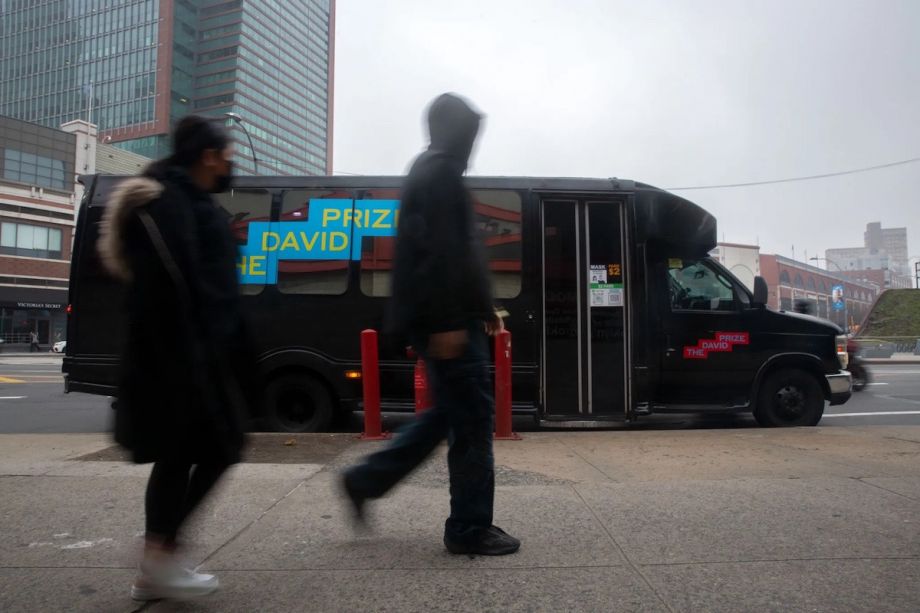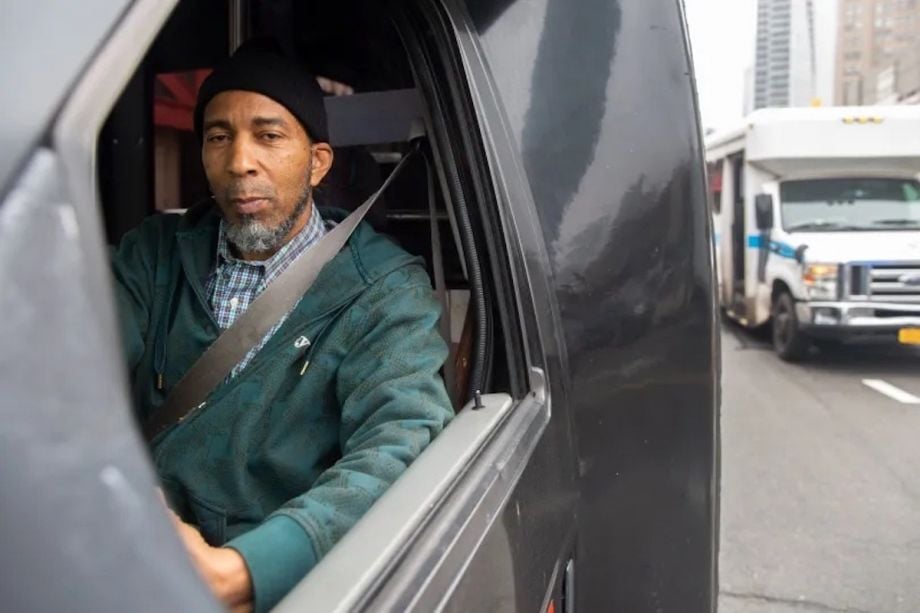This story was originally published on April 7 by THE CITY. Sign up here to get the latest stories from THE CITY delivered to you each morning.
For nearly 30 years, Carmen Grant-White drove a “dollar van,” shuttling New Yorkers around southeast Queens as part of the city’s extensive shadow transit network.
These days, her licensed commuter van stands still in the driveway of her St. Albans home, sidelined since March 2020 by the long-running struggles facing a transportation sector that has been slammed by the pandemic, an increase in competition from unlicensed operators and soaring insurance costs.
“I cannot afford it,” Grant-White told THE CITY this week. “It’s costing $36,000 a year and there is no way in heaven I can afford it, not at all.”
Doing business in heavily immigrant neighborhoods in Brooklyn, Queens, Manhattan and The Bronx that tend to be short on public transportation options, the dollar vans do not have official stops or schedules. They largely emerged during the 1980 transit strike, and proliferated in the latter part of that decade with rides originally costing a buck. They generally still cost less than the $2.75 MTA bus fare, although some routes charge as much as $3.
But Taxi and Limousine Commission data shows there were only 31 TLC-affiliated commuter vans in service as of Thursday — an 86% drop from 2019, when there were 215 on city streets. In 2015, there were 584 dollar vans licensed to operate within certain zones, according to TLC records.
The number of licensed commuter van drivers has shrunk to 69, according to the TLC numbers, as operators have shifted to driving vans that are not licensed or have taken new jobs. There were 223 licensed drivers as recently as 2019.
Grant-White is among those who got out, yet she’s still on the road: The 62-year-old now drives a school bus.
“It’s reasonable and I can get some money,” she said of the new gig. “But right now, I am just living hand to mouth, I can’t hardly pay the bills.”
Vivian Barnes, a licensed van driver in southeast Queens who has been behind the wheel along Linden and Merrick boulevards since 1987, said he is being driven to quit by his inability to cover insurance costs.
“It’s the first time I have ever seen it so bad and I don’t know if I can continue with it,” Barnes, 78, told THE CITY Thursday. “I would really like to continue with it until God tells me no more, that it’s time to go home.
“But I can’t.”
Drivers said routes in sections of the city that have long been strongholds for dollar vans have largely been left to unlicensed carriers, who often operate without insurance, or while underinsured.
“The Brooklyn route and the Queens route have practically almost shut down,” said Winston Williams, 61, a driver for nearly three decades and owner of Blackstreet Van Lines, which operates along Flatbush Avenue in Brooklyn. “The licensed vans, they are mostly in the Chinatown area,” Williams said, referring to the three Chinatowns in Lower Manhattan, Sunset Park and Flushing.

The door of Winston Williams’s van says “Fare $2,” April 5, 2023. (Photo by Ben Fractenberg / THE CITY)
The TLC does not have an estimate of how many unlicensed vans are on city streets.
Drivers said colleagues often give up their TLC licenses to make more money on the road with less hassle.
“A lot of the guys went on to Uber, to school bus companies, some went on to Access-A-Ride and others are operating without permits,” said one unlicensed driver on the Flatbush Avenue route, who asked not to be identified by name. “They still have to support their family and put food on the table.”
Ready to Return
The continued collapse of the licensed commuter van sector contrasts how subways and buses have been faring. Their weekday ridership has climbed back to around 65% of pre-pandemic levels, according to MTA data.
But for the licensed commuter vans, the return has been largely slowed by rising annual insurance rates. Advocates for commuter van operators blamed the higher rates on the vans no longer having a separate insurance classification, but instead being in the same category as charter buses and ambulettes.
“The rates are exorbitant, up to $40,000 per vehicle, and we can’t do business under such rates,” Hector Ricketts, president of the Commuter Van Association of New York told THE CITY. “We’re ready to come back, customers are waiting for the commuter vans, drivers are ready to go back to work, but the insurance is prohibitive.”
State Sen. John Liu (D-Queens), a Transportation Committee member whose district includes a portion of the route that runs between largely Asian communities in Flushing, Elmhurst, Lower Manhattan and Sunset Park, told THE CITY that the lack of affordable insurance options is “essentially a death knell” for the licensed commuter van business.
The 2023 state budget includes $11 million in funding for a new Commuter Van Stabilization program, which is designed to subsidize driver insurance rates. But driver advocates and elected officials said that without changes to how much commuter vans pay for insurance, the regulated business will continue to shrink.
“It’s not just the commuter van operators who are suffering, but the public who is being dealt the short end of the stick,” Liu said, pointing to the state’s Department of Financial Services as “the main culprit behind the extreme difficulties that are slowly killing off the commuter vans.” The agency supervises and regulates nearly 3,000 financial institutions, including insurers.
While the $11 million has been set aside for the Commuter Van Stabilization program, a Department of Financial Services spokesperson told THE CITY that the funds will not be allotted until a working group made up of state and local agencies figures out exactly how it can provide financial support to drivers, improve safety and make insurance coverage more affordable.
Responses to a request for proposals for a stabilization program administrator are still being reviewed, the spokesperson added, so one can be brought in to begin distributing funds and managing safety upgrades.
Without changes, Ricketts predicted, more formerly licensed drivers will go behind the wheel in unregulated or underinsured vehicles.
“You can’t put a dollar figure on the safety,” he said. “The licensed vans are obviously safer, they are fully insured, the drivers are fingerprinted and they have a commercial drivers license and a hack license.”
Another formerly licensed driver who said he now drives his commuter van along Merrick Boulevard in Queens “very, very, very, very sparsely,” said some customers have shifted to riding on nearby MTA bus routes.
“The buses practically run for free,” said the driver, 70, who asked not to be identified by name. “The people aren’t paying and [the bus operators] do not ask for people to pay and the people know that.”
It adds up to a changing scene for riders who relied on commuter vans.
“They used to just walk outside and get vans,” the veteran van driver said. “Now if someone gets in they say, ‘What happened to you guys, where are you?”
THE CITY is an independent, nonprofit news organization dedicated to hard-hitting reporting that serves the people of New York.

Jose Martinez is THE CITY’s transportation reporter. He previously worked on-air for six years at NY1 News, where he also hosted the weekly “In Transit.” He is a veteran of the city’s tabloids, covering courts at the Daily News and the New York Post. He began at the Journal News in Westchester County.
















